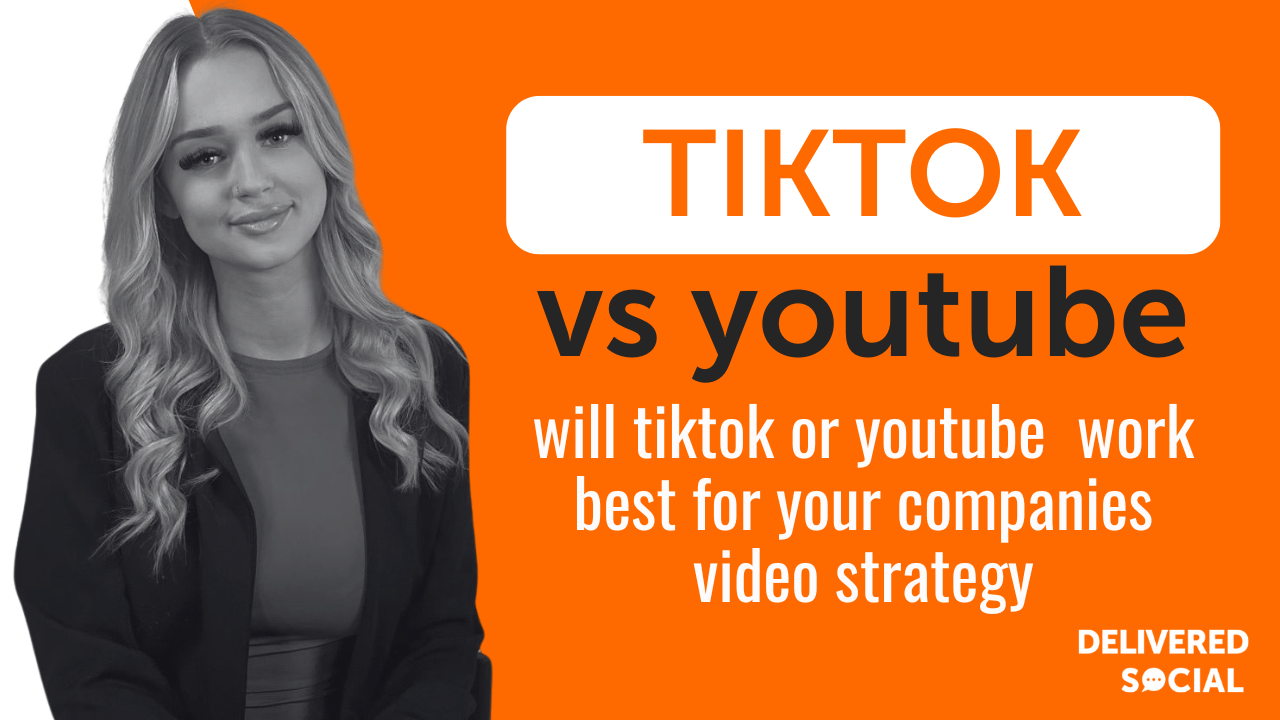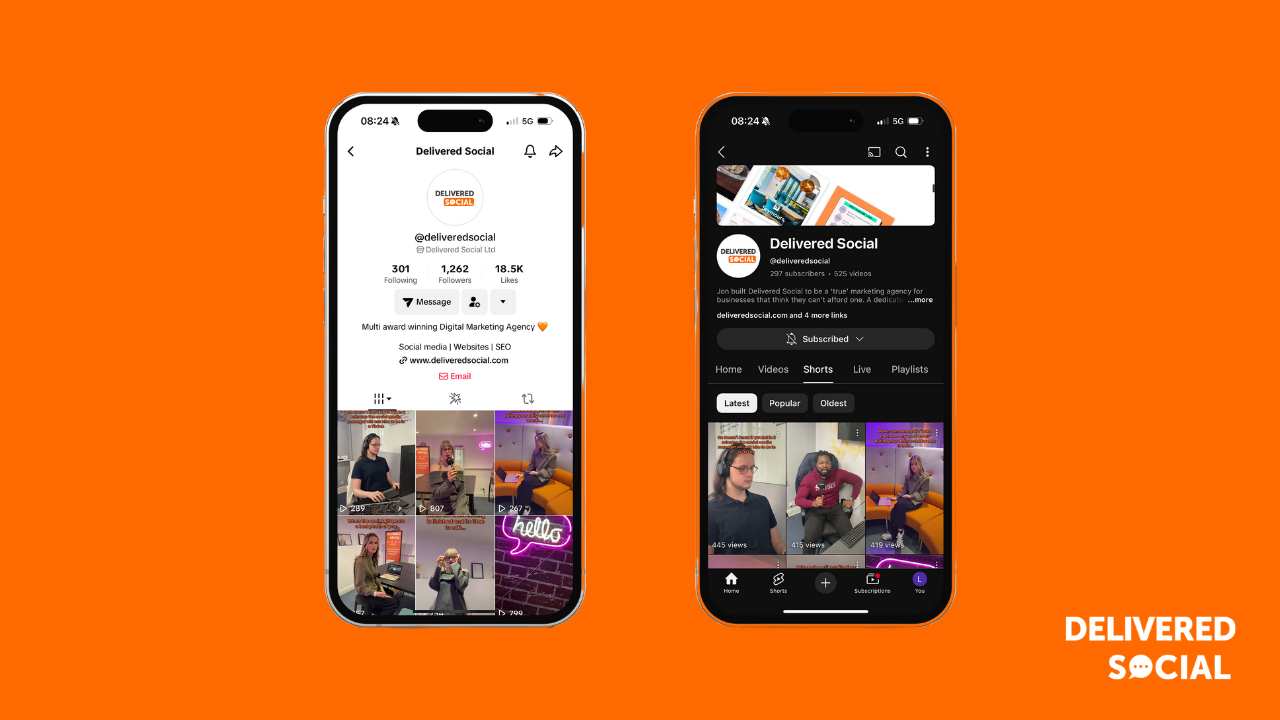
TikTok and YouTube have become two of the biggest names in the social media landscape, revolutionising how content is consumed, created, and shared. Both platforms offer unique opportunities for creators and businesses to engage with their audience, but how do you decide which one is best for your brand?
In 2025, TikTok has continued its meteoric rise, capturing the attention of a younger, trend driven demographic with its short form, fast paced content. On the other hand, YouTube has solidified itself as the go to platform for longer, high quality videos and remains a leader in video content creation. With the rise of YouTube Shorts and TikTok Shorts, both platforms are now focusing heavily on short form video, increasing the overlap in their content types.
But when it comes to selecting the right platform for your business or personal brand, there’s more to consider than just the popularity of the platform. Each platform has its own audience, engagement tactics, and content formats that influence what works best. This article will help you understand the strengths and weaknesses of TikTok Vs YouTube in 2025 and determine which platform aligns best with your audience, goals, and content style.
We’ll also dive into specifics such as TikTok Vs Shorts, TikTok Search Vs YouTube Search, and how both platforms are evolving in this new era of short form content.
Audience Demographics: Understanding Your Viewers

When it comes to choosing between TikTok and YouTube, understanding the audience on each platform is essential. Both platforms attract a wide range of viewers, but the key to success lies in identifying which platform appeals to your target demographic and how to tailor your content accordingly.
TikTok is often associated with a younger audience, particularly Generation Z and millennials. The platform’s algorithm, which focuses on personalisation and engagement, has made it a hotspot for short, punchy videos that appeal to those looking for entertainment, trends, and viral challenges. In fact, TikTok’s short form content has become incredibly popular with users under 30, making it a powerful tool for reaching younger consumers who are quick to embrace new trends. If you’re targeting a demographic that thrives on quick, easily digestible content, TikTok could be the right choice for you.
On the other hand, YouTube appeals to a broader age range, with its established user base extending from teens to adults and professionals. While YouTube Shorts has brought short-form video to the platform, YouTube is still recognised for its long-form, highly polished videos. YouTube’s users are often looking for educational content, tutorials, reviews, and entertainment that provides more depth and insight. If you’re aiming to provide value through longer content, YouTube may be the better choice. Additionally, YouTube provides a more professional space for creators and businesses to build a personal brand, showcasing expertise and authority within a particular field.
When deciding between TikTok and YouTube, businesses should align their choice with the age, interests, and content preferences of their target audience. Whether it’s the fast paced, trend driven nature of TikTok or the long form, educational focus of YouTube, understanding your audience’s habits will guide your decision making.
Content Types and Engagement: TikTok Vs YouTube Shorts
When comparing TikTok and YouTube Shorts, it’s important to understand how the content types on both platforms perform and what engages their respective audiences. Both platforms have jumped on the short form video bandwagon, but the approach to content and user interaction differs in ways that can impact your strategy.
TikTok is the pioneer of short form content. The platform thrives on viral challenges, trends, and relatable, authentic content. Videos on TikTok are generally designed to be fast paced and eye catching, with users scrolling through an endless stream of videos that keep them hooked. Engagement on TikTok is high, users can easily comment, share, and like videos, leading to rapid exposure. Because TikTok is so focused on organic discoverability, your content has a high chance of going viral if it resonates with the audience. TikTok’s algorithm is built around engagement, so the more people interact with your video, the more it gets promoted to others.
YouTube Shorts, on the other hand, has positioned itself as a complementary feature to YouTube’s traditional long form videos. YouTube Shorts are designed to be quick, bite sized videos (under 60 seconds) that are great for summarising content, teasing new videos, or reaching a different audience. While Shorts is a relatively new feature on the platform, it’s growing rapidly and has become a strong competitor to TikTok, especially for creators already established on YouTube. The main difference lies in the engagement style, while TikTok focuses on instant, viral interaction, YouTube Shorts are more likely to lead viewers to longer videos on your channel.
When it comes to engagement, TikTok’s interactive features, such as Duets and Trends, make it a unique platform for viral marketing. However, YouTube Shorts tends to provide a more polished and structured form of engagement, often helping creators build deeper connections with their audience through cross platform content. Both platforms have the potential to boost your visibility, but understanding how the search on TikTok vs YouTube affects content discovery is key. On TikTok, content tends to be discovered through the “For You” page, which is driven by engagement and algorithmic recommendation. On YouTube, content is often discovered through search and suggested videos, giving creators the chance to rank higher based on search intent.
To learn more about maximising your content reach across different platforms, check out our article on Repurposing TikToks for Other Networks and Maximising Content Reach.
Video Discovery: TikTok Search Vs YouTube Search
When it comes to video discoverability, both TikTok and YouTube offer powerful algorithms, but they work very differently. Understanding how TikTok search vs YouTube search operates is key to making sure your content is reaching the right audience and achieving maximum visibility.
On TikTok, the discovery process is largely driven by the For You Page (FYP), a personalised feed of videos based on a user’s preferences, interactions, and the content they engage with most. TikTok’s algorithm relies heavily on engagement metrics, such as likes, shares, comments, and watch time, which means the more interactions your video gets in its first few hours, the more likely it is to be promoted. This gives content creators the potential for viral success, even if they have a relatively small following. TikTok also uses hashtags to help users discover content, but its algorithm is far more focused on engagement and how relevant your content is to a user’s interests.
In contrast, YouTube search functions in a more traditional way. Users typically go to YouTube with specific intentions, whether they are searching for a tutorial, a review, or general entertainment. The YouTube algorithm uses a combination of factors like keywords, descriptions, metadata, and watch history to rank and recommend videos. Videos that align well with a user’s search query are more likely to be surfaced in search results. YouTube also offers suggestions based on users’ past viewing habits, but the algorithm is more focused on search intent than engagement.
The key takeaway here is that TikTok’s algorithm is built to encourage virality and spontaneous discovery, making it ideal for creators who want to reach a wide audience quickly. On the other hand, YouTube search allows for more deliberate, long term content discovery, giving creators the opportunity to be found based on specific queries and interests. For businesses, understanding these differences can guide the strategy for how to best utilise both platforms for content marketing.
Discover more about creating seamless video transitions for social media with our guide on Top Tips for Social Media Video Transitions You Can’t Ignore in 2025.
Monetisation: How Creators and Brands Can Benefit

Both TikTok and YouTube offer various opportunities for creators and businesses to monetise their content. However, the pathways and potential earnings differ between the two platforms, making it important to understand which one is best suited for your business or personal brand’s goals.
On TikTok, monetisation has traditionally been more limited but has evolved rapidly in recent years. TikTok offers a Creator Fund that pays creators based on the engagement their videos receive, though eligibility for this fund can be restrictive. In addition to the Creator Fund, creators and businesses can monetise via brand partnerships and sponsored content. Given the high level of engagement and virality on TikTok, brands are increasingly looking to collaborate with influencers to boost product visibility. TikTok also allows users to include affiliate links in their videos, which can be a lucrative way for businesses to drive sales.
Additionally, TikTok offers Live Gifts and TikTok Shop, which allow users to engage with audiences through live streams and sell products directly on the platform. This feature is particularly valuable for e-commerce businesses looking to create a more interactive shopping experience. Brands can also use TikTok’s ads platform to target specific audiences and increase brand awareness or drive traffic to websites.
YouTube, by contrast, has long been a leader in video monetisation. Creators can earn revenue through the YouTube Partner Program (YPP), which offers ad revenue sharing based on video views. YouTube ads appear before or during videos, and creators are paid based on how many viewers watch these ads or interact with them. YouTube also has Super Chats for live streams, memberships, and even merchandise shelf integration, giving creators multiple ways to make money.
For businesses, YouTube’s longer form content is ideal for showcasing products, services, and thought leadership through tutorials, reviews, or behind the scenes videos. While monetisation on YouTube is heavily reliant on views and engagement, it’s often more sustainable than TikTok’s shorter term viral success.
Both platforms provide ample opportunities for creators to monetise content, but YouTube offers more traditional and diverse revenue streams, while TikTok focuses more on organic reach and influencer marketing. Deciding which platform is better for monetisation depends on your content style, target audience, and marketing goals.
To explore how user generated content is reshaping social media marketing, check out our article on How Social Media Has Changed Marketing: The Power of Video UGC.
FAQs: TikTok Vs YouTube
1. Which platform is better for brand awareness: TikTok or YouTube?
TikTok is better for quick, viral brand awareness with its algorithm driven For You Page. YouTube is better for long term engagement and content discovery, especially with search driven traffic.
2. How does monetisation differ on TikTok vs YouTube?
TikTok offers monetisation through brand partnerships, the Creator Fund, and TikTok Shop. YouTube offers more options like AdSense, Super Chats, and merchandise integration, making it better for consistent revenue.
3. Is TikTok better for reaching younger audiences than YouTube?
Yes, TikTok is predominantly used by Gen Z and millennials, while YouTube has a broader audience, including a wider age range from teens to adults.
4. Can I repurpose content across both TikTok and YouTube?
Yes, but it’s important to adjust your content slightly to fit the style and culture of each platform, as TikTok thrives on trends and YouTube Shorts on summarising content.
5. Which platform is better for driving traffic to my website?
TikTok is good for immediate engagement and driving quick traffic, while YouTube can bring steady traffic over time, especially through video descriptions and search driven content.
Interested In Working Together?
Introducing Delivered Social. We’re The Most-Rated Digital Agency In Surrey & Hampshire – We’ve Got To Be Doing Something Right.
Delivered Social is a digital marketing agency with one mission—to help businesses grow. We’re famous in Guildford and Portsmouth for our social clinics. We believe in free advice. We build lasting relationships because our team prides itself on being helpful, which our clients appreciate.
If you are looking for a new website or an agency to manage your social media presence, we can help.
If you need something slightly different, here's a super handy list of all our services, or you can always email us.



















